After my visit to the Cathedral in Milan, which by its size is the third largest church in the world, I started with a tour which I had envisaged myself in order to finish it with a visit to a specific museum – the Museum of Cultures or Mudec for short.
Along the way, I had a fantastic ice-cream and I enjoyed it additionally since it was very warm and as I was going along the streets, I could also go to their shady side and it was more pleasant there.
My next destination was St. Ambrose’s Basilica. I walked in the general direction of the church, but in that part of the city the streets are completely jumbled, at strange angles, small and short, and the tourist map was completely inadequate for it did not show the names of those small streets and thus I was very confused and had no idea how to get my orientation straight and where I was, and that is a VERY rare phenomenon in my life. Luckily, it was a sunny day and I decided to simply move in the desired direction, but using the Sun as the landmark. And then after a while I came across a street that was large enough to be on the map and as it was right on my way, I was so delighted with myself and my urban orienteering skills that I felt like patting myself on the back!
But, joking aside, when one is travelling, it is really important to be resourceful and that is more easily attained if you have broader knowledge, including also the one about the Sun, its apparent movement and the points of compass. Although this may seem at first sight as a given, it is important to bear in mind, for instance, that on the south side of the Earth’s sphere the things are “reversed” and therefore one needs to account for such details.
OK, enough with the lecturing, I should go back to my visit to the St. Ambrose’s Basilica. I reached it from its back side and there I came across an entrance into a courtyard that turned out to belong to this church actually and it looked really very pretty.
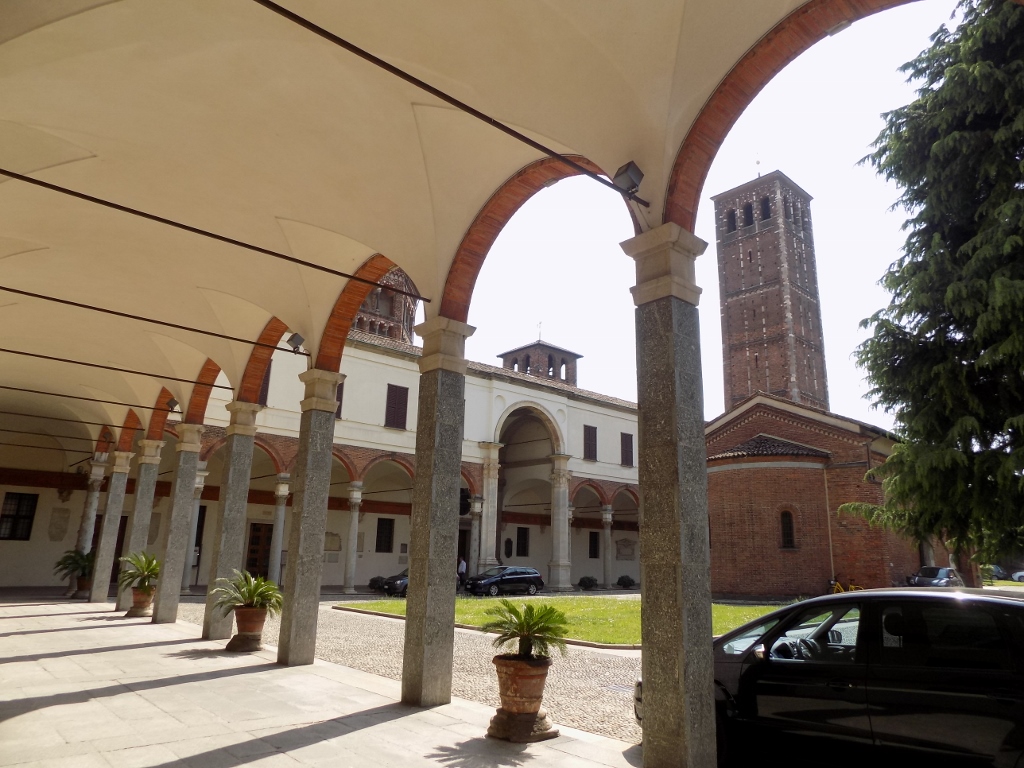 St. Ambrose’s Basilica, the courtyard on the side of the church
St. Ambrose’s Basilica, the courtyard on the side of the church
There I also saw a sign pointing towards the Basilica, but if it hadn’t been for some people I would have probably not entered the church through a small door that actually led right towards the sanctuary.
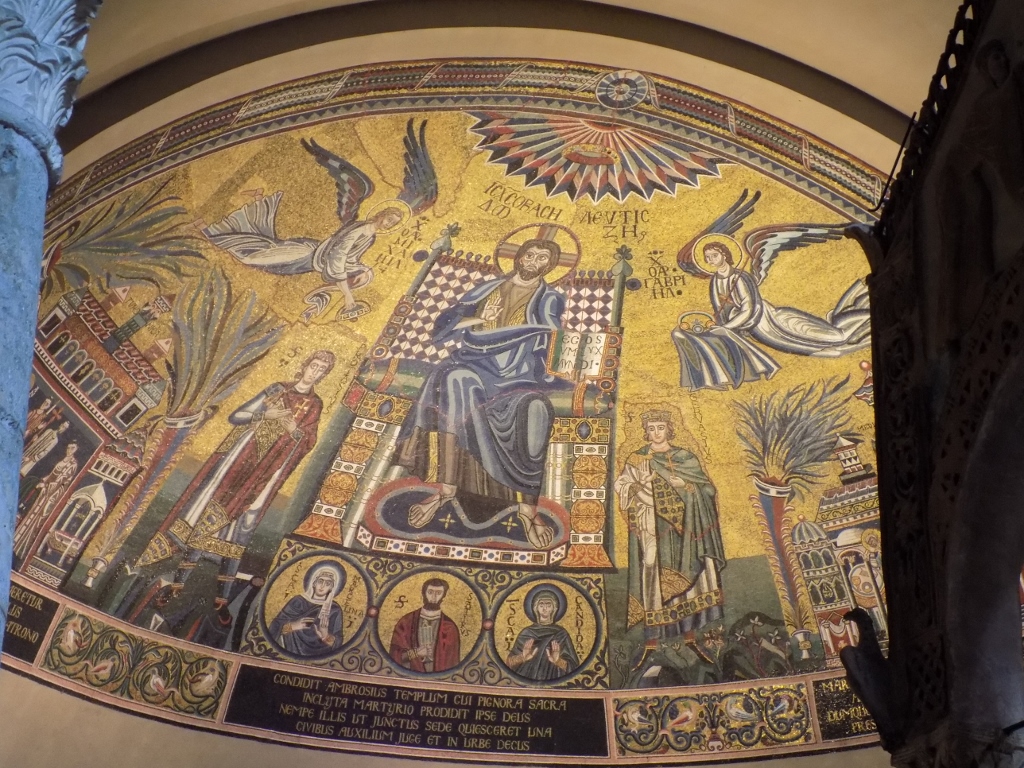 St. Ambrose’s Basilica, the mosaic of Christ Pantokrator
St. Ambrose’s Basilica, the mosaic of Christ Pantokrator
This, exceptionally interesting basilica was founded in the 4th century, but the present structure dates back from the 11th and the 12th centuries. It has two belfries, from the 9th and the 12th centuries, respectively, but what is particularly attractive about it is its atrium through which I was in fact leaving the church on this occasion. That space is particularly pretty and there it is possible to see not very many, but very nice decorations, including remains of a fresco, as well as very interesting capitals. I stayed there for a while and looked around in order to see as much as possible, as well as to take photos, and then I went on.
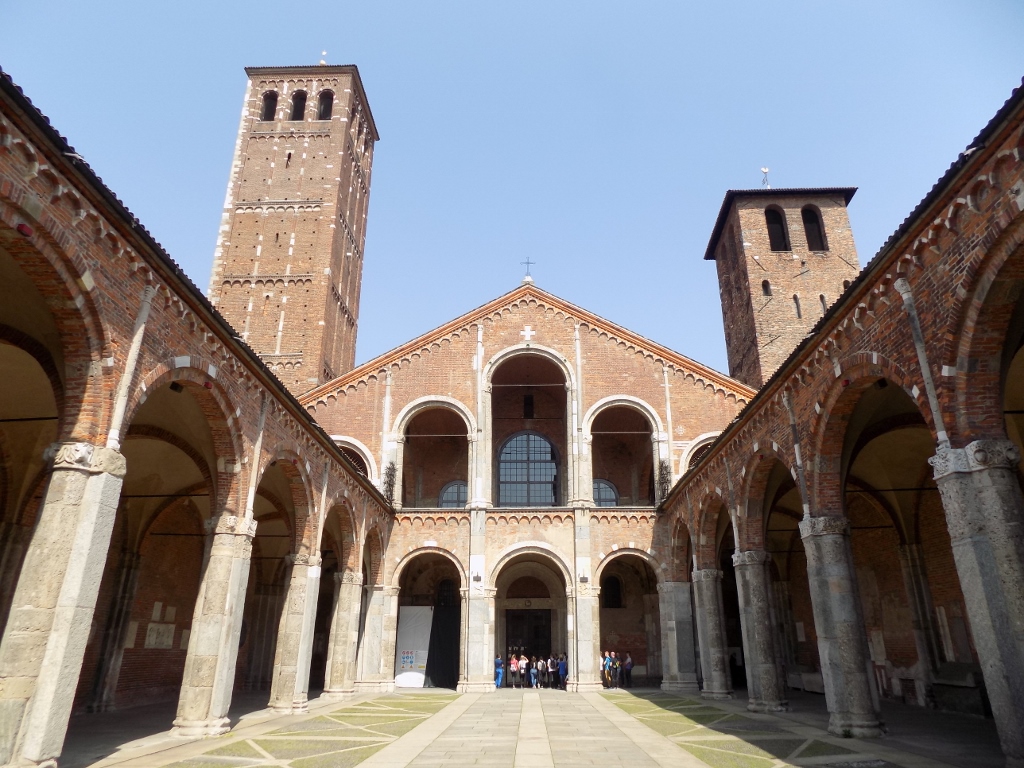 St. Ambrose’s Basilica, the atrium and the entrance into the church
St. Ambrose’s Basilica, the atrium and the entrance into the church
I passed by the Ticinese Gate and let me be clear – I’m thinking of the medieval one. Namely, there are in fact two gates of the practically same name, one from the Middle Ages and the other from the times of Napoleon. The one I’m talking about, Porta Ticinese Antica, is one of only two medieval gates that have survived to date and it is located in the south. In the past, the present-day centre of Milan was surrounded by the 14th-century ramparts. With time, only some parts have remained (including the Porta Ticinese, Porta Nuova in the north, as well as the Castle of the Sforzas). At the time when it was built (14th century), the Castle did not bear this name, since the Sforzas had not yet started to rule Milan (they commenced around the middle of the 15th century), but it was certainly a part of the defence system. Today, the circular route of the ramparts is followed by a boulevard.
The next place on my way was the Church of St. Eustorgius, Sant'Eustorgio. This concerns a saint, Eustorgius, who lived in the 4th century when it is presumed that the church was founded. Eustorgius was the bishop of Milan and according to the legend, it was him who brought the remains of the Magi from Constantinople to Milan, which were later, in the 12th century, taken over by Frederick Barbarossa and transferred to Cologne, Germany. It was only at the very beginning of the 20th century that some small parts of the remains were returned to this basilica and all of this is symbolically visible on the top of the belfry which is marked by a star and not by a traditional cross.
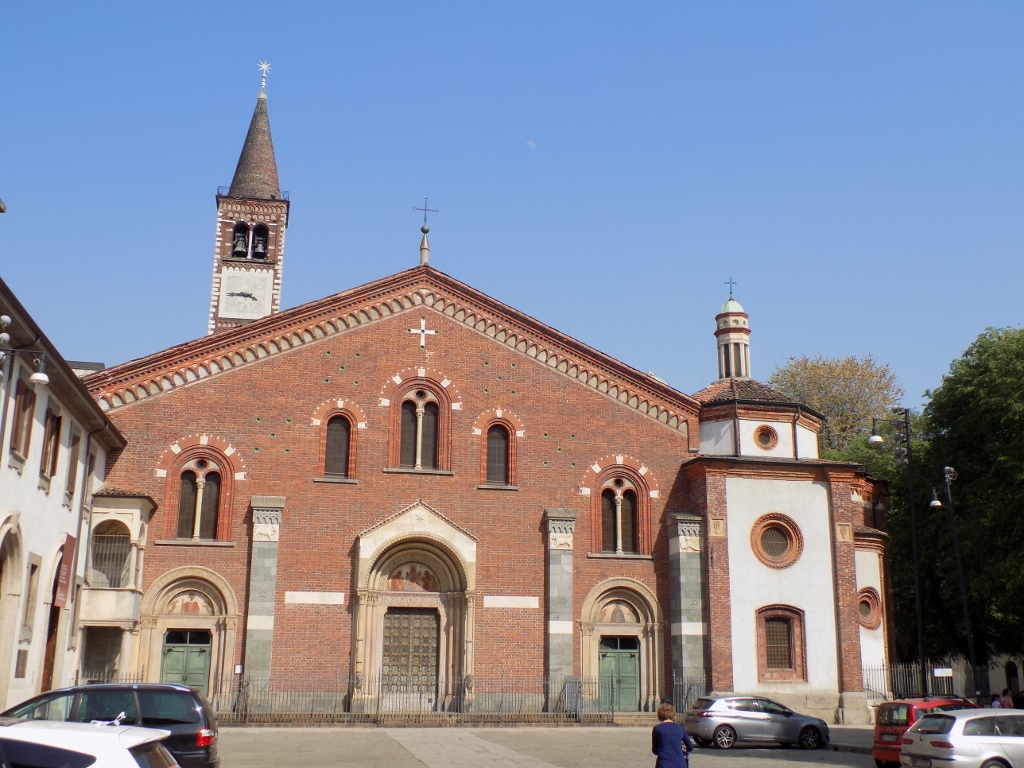 Church of St. Eustorgius, note the star on the top of the belfry
Church of St. Eustorgius, note the star on the top of the belfry
As I was standing on the plateau in front of the church, everything seemed closed and desolate, but I decided nonetheless to approach the door and try to open it. It worked and I entered. At first, everything was very dark, since outside the sun was shining with all of its might, but soon my eyes adjusted. While I was walking slowly around the church, going to its back section, I was approached by a gentleman who drew my attention to precisely what I was looking for. It was Portinari Chapel and that gentleman was selling tickets for the entrance into the chapel, so when he was not busy he left his post in a cloister parallel to the main nave and entered the church in order to hunt for visitors. As it happened, I was completely alone when I first entered the chapel and it is really a fantastically beautiful place.
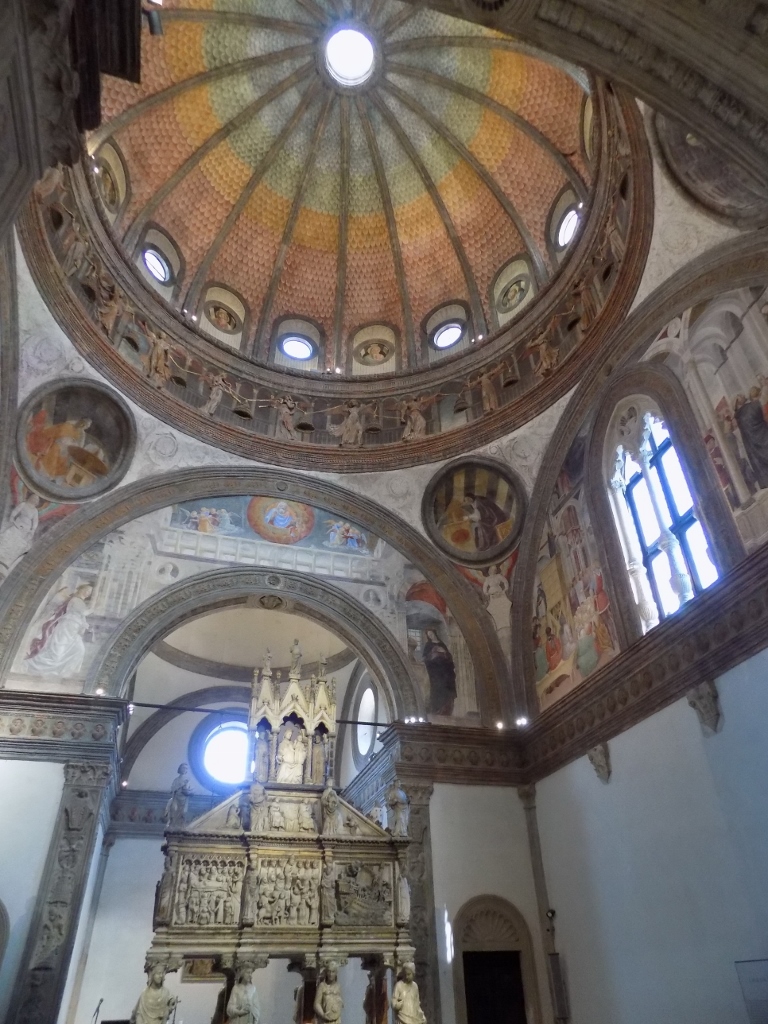 Church of St. Eustorgius, Portinari Chapel
Church of St. Eustorgius, Portinari Chapel
The chapel was built during the Renaissance and it contains frescoes that depict the life and death of St Peter Martyr. There is also a line of reliefs under the dome, while in the middle there is a richly decorated marble tomb containing the remains of this saint.
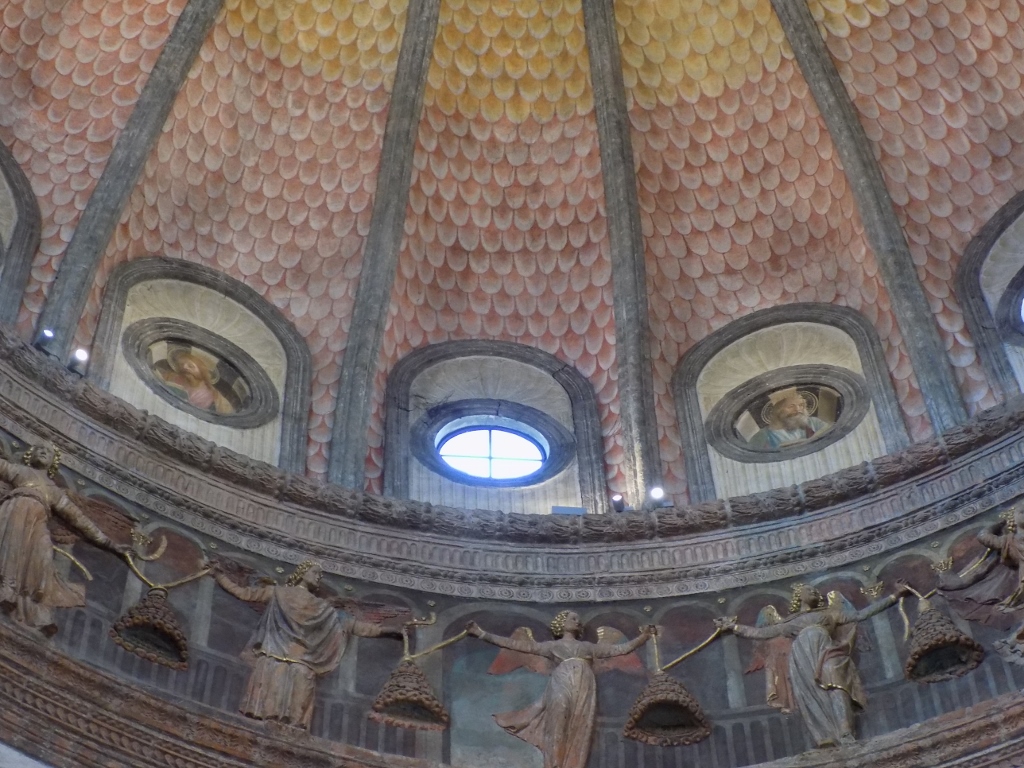 Portinari Chapel, a detail
Portinari Chapel, a detail
When I returned to the church from the Portinari Chapel, I realized it was not as dark as it first seemed, but I did had to move on and the next point of visit on this day was a part of Milan in which there are navigable canals where there are organized cruises.
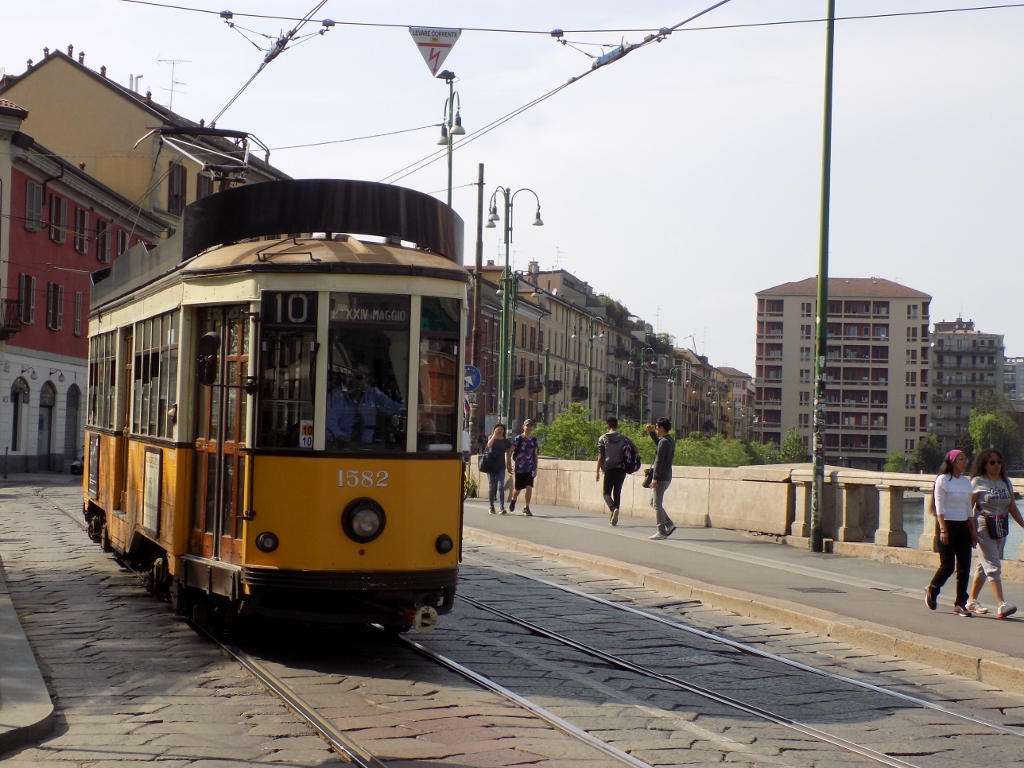 A detail from the surroundings of the canals
A detail from the surroundings of the canals
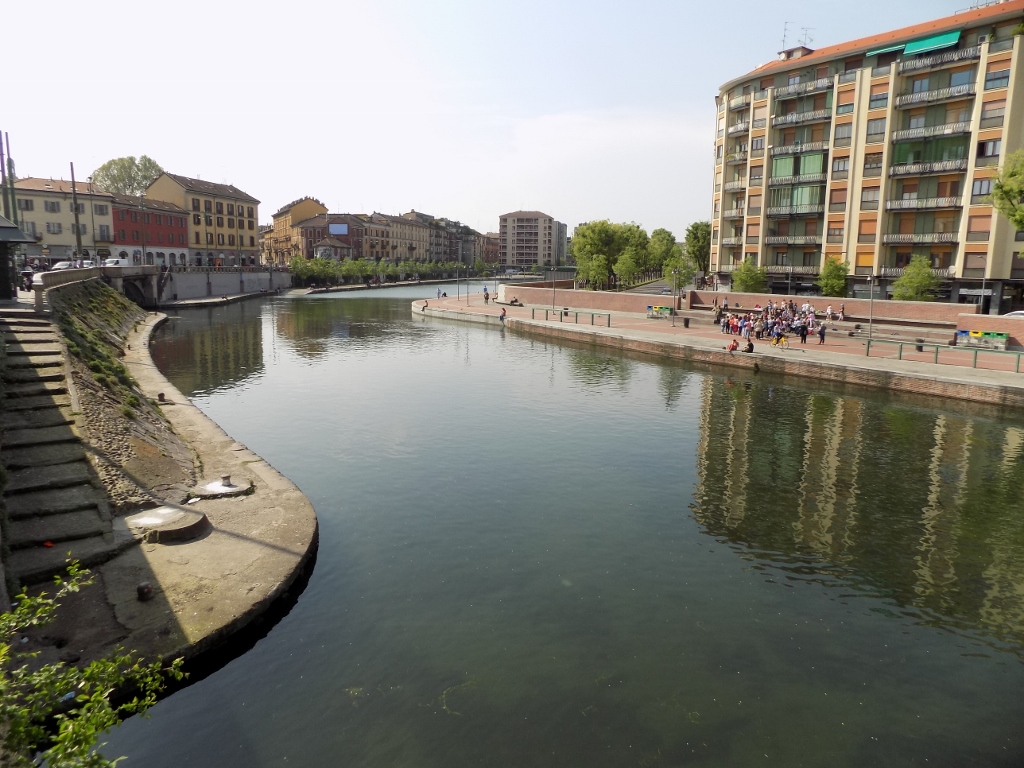 Darsena, the place where two large canals join each other – Naviglio Grande and Naviglio Pavese
Darsena, the place where two large canals join each other – Naviglio Grande and Naviglio Pavese
Namely, from the 12th to the 16th century, a network of navigable canals was built in Milan and even Leonardo gave his contribution to this system at the end of the 15th century. Thanks to these canals, Milan was connected not only to the numerous lakes that surround it, but also to the sea and it was along these canals that all of the marble for the building of the Duomo or the Cathedral was transported. The canal system represented one of the main transportation ways up until the onset of faster means when the system started to decline. However, today, the Navigli, i.e., the canals and their surroundings are very popular, not only because of the possibility to take boat tours, but also because of the large number of art galleries, places with music, restaurants and bars that are located in their vicinity.
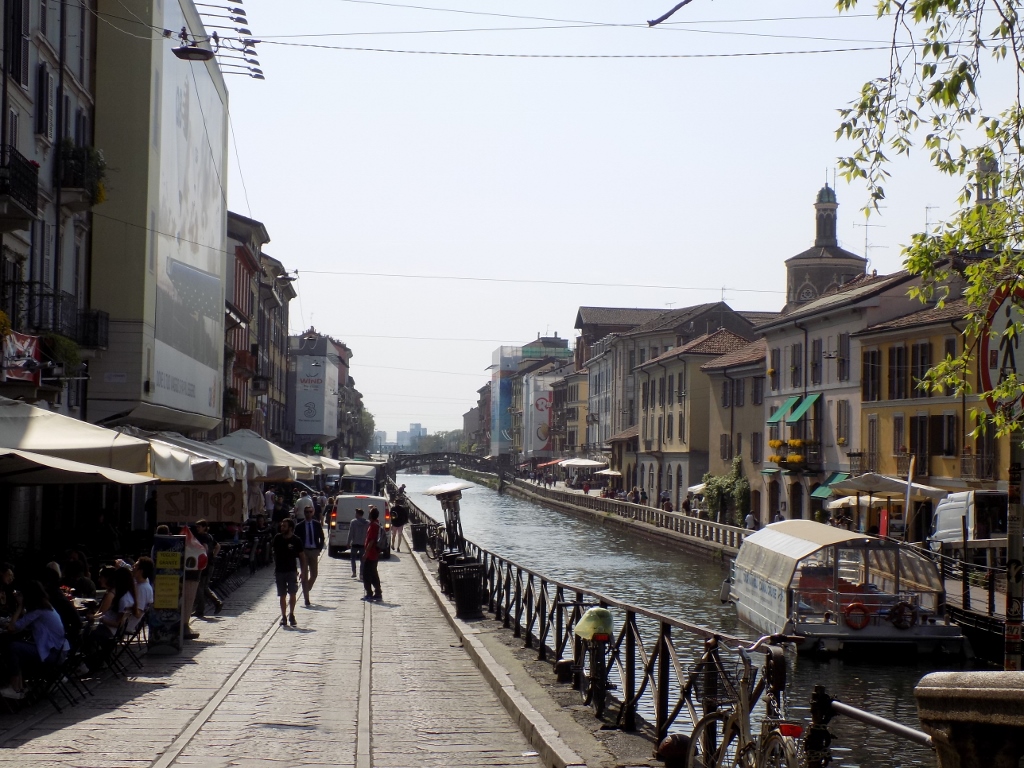 Naviglio Grande
Naviglio Grande
Unfortunately, as much as it was inspirational to sit in one of these bars I was passing by, I did not have the time to stay there in order to reach the museum while it was still open, but I certainly made some stops in order to take a better view at the area and take photos.
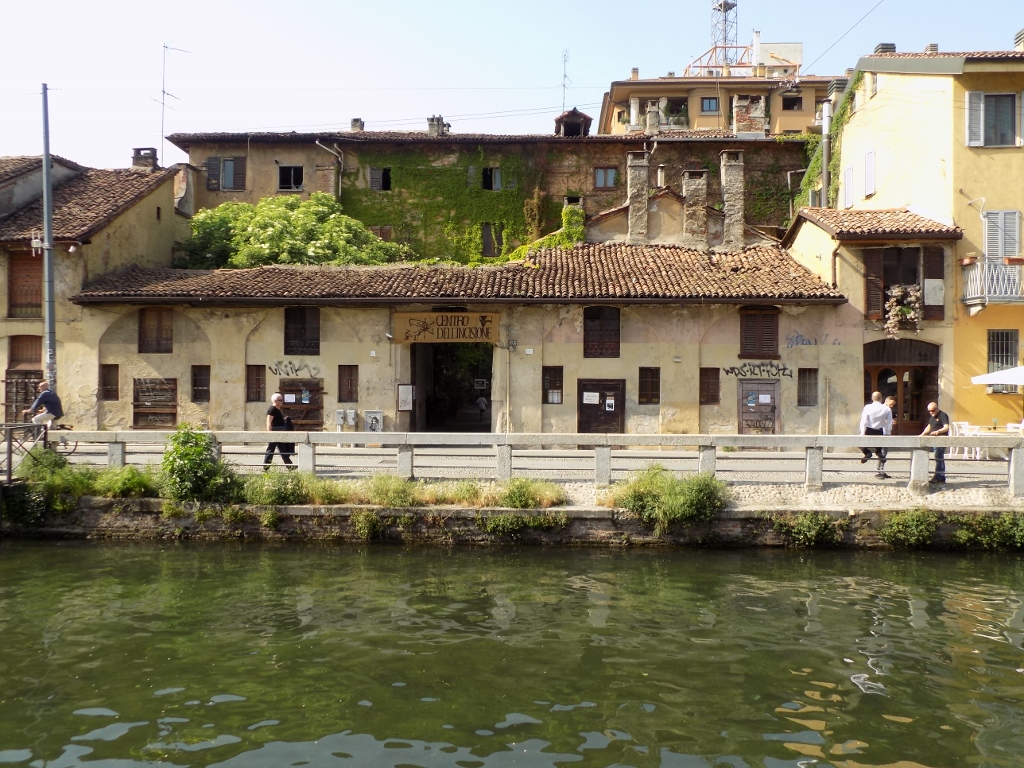 One of the art centres by the Naviglio Grande
One of the art centres by the Naviglio Grande
Actually, the main reason why I decided to visit precisely what I was visiting was that passing through Milan during my arrival in Italy, I saw that my visit coincided with a Frida Kahlo exhibition which I did not want to miss out on, although it had nothing to do with Italy. Still, in order to reach the museum, I kept walking beside the canal, but in a section where apart from the paved walking area there was nothing else. As it turned out, even the bridge I was supposed to take in order to get onto the other side of the railway tracks that run parallel to the canal was rather far away. The sun was going down and shone directly into my face, making me quite hot, but I persevered and soon found myself at the Mudec (the museum).
The exhibition showed not only some of the pieces of the nowadays famous Frida Kahlo, but also a lot of photographs and documents that shed additional light onto her life. Although I had not seen that many of her works in one place, taking into account that I had first read a book about her and Diego Rivera more than 25 years before and that in the meantime I had also read some monographs dedicated to her, I had an impression that I didn’t really see or learned anything particularly new. This, however, did not diminish in any way my enjoyment in her works, her uncommon, original and exotic beauty, as well as the emotional stirring on account of a fate so unbelievably fantastic, unusual and unique, and yet concurrently so tragic and moving.
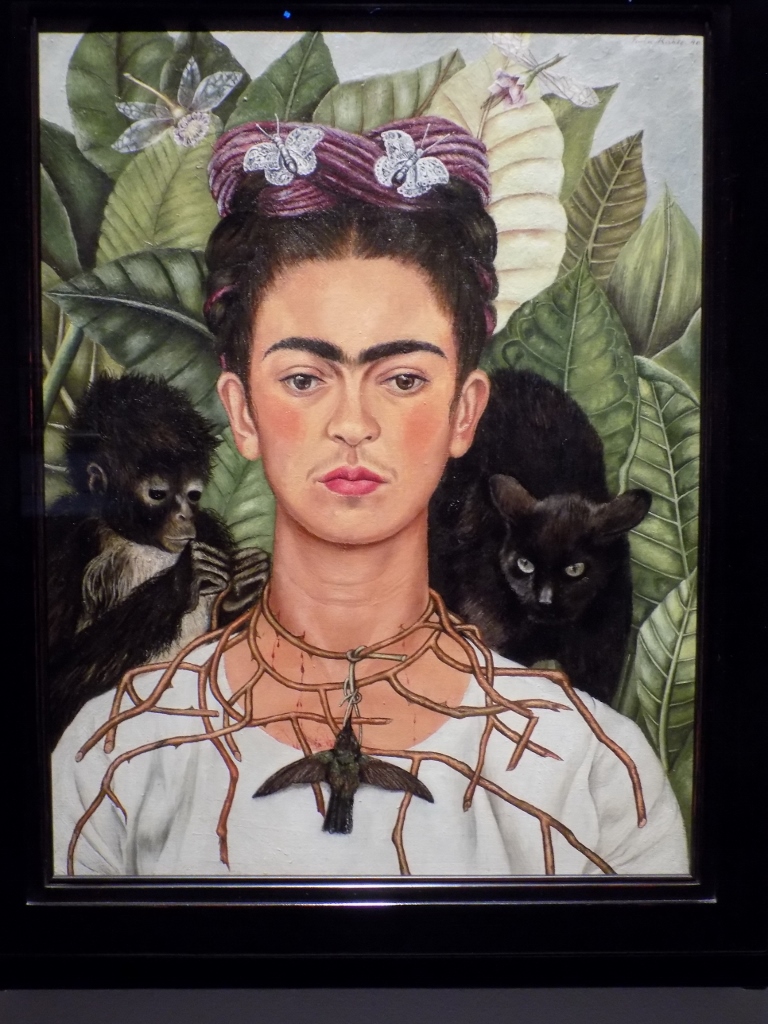 Frida Kahlo: Self-portrait with Thorn Necklace and Hummingbird
Frida Kahlo: Self-portrait with Thorn Necklace and Hummingbird
I saw the exhibit at ease, not paying any attention to the time, but once I had finished, the moment came for me to get into the hundredth gear. I had a train to Bergamo in approximately 45 minutes, but I also had a mad plan. So, first I walked to an underground station that was relatively close to the museum. Then I changed two trains and then, walking speedily, I climbed the stairs that led me out onto the Piazza del Duomo, i.e., to the square in front of the Cathedral. The reason – it was late afternoon, the sky was cloudless, the sun was slowly setting, which all together meant that the front of the Cathedral was fantastically lit and I wanted to take a photo of that (and, of course, to see it).
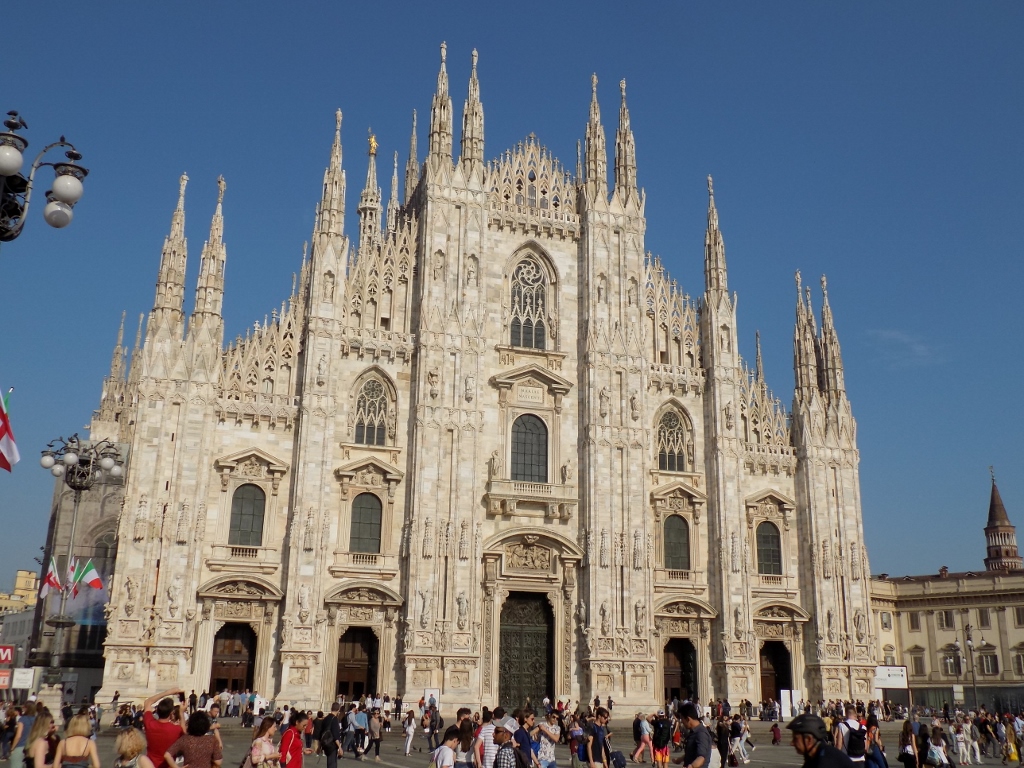 The Cathedral of Milan in the late afternoon
The Cathedral of Milan in the late afternoon
So, I ran around the square, taking a few photographs, and then hastily went underground again. From there I took a train to get to the main railway station, which also entailed walking through the long hallways that connect the underground and the train systems in this part of Milan. Then I bought the ticket (I did not have a return ticket, since I had some “original” ideas about my return that I had discarded in the meantime) and soon I sprinted into the train. I sat on the only available seat just 3 minutes before the train departed! Of course, I could have taken the next train, but it was scheduled one hour later and since I didn’t really care in particular about the train station I didn’t feel like hanging out that long.
As opposed to the haste to the train station in Milan, the evening in Bergamo was very peaceful. After a light and simple dinner, I went to the same bar in the square where the flat I was staying at was located and in which I had already been the previous two evenings.
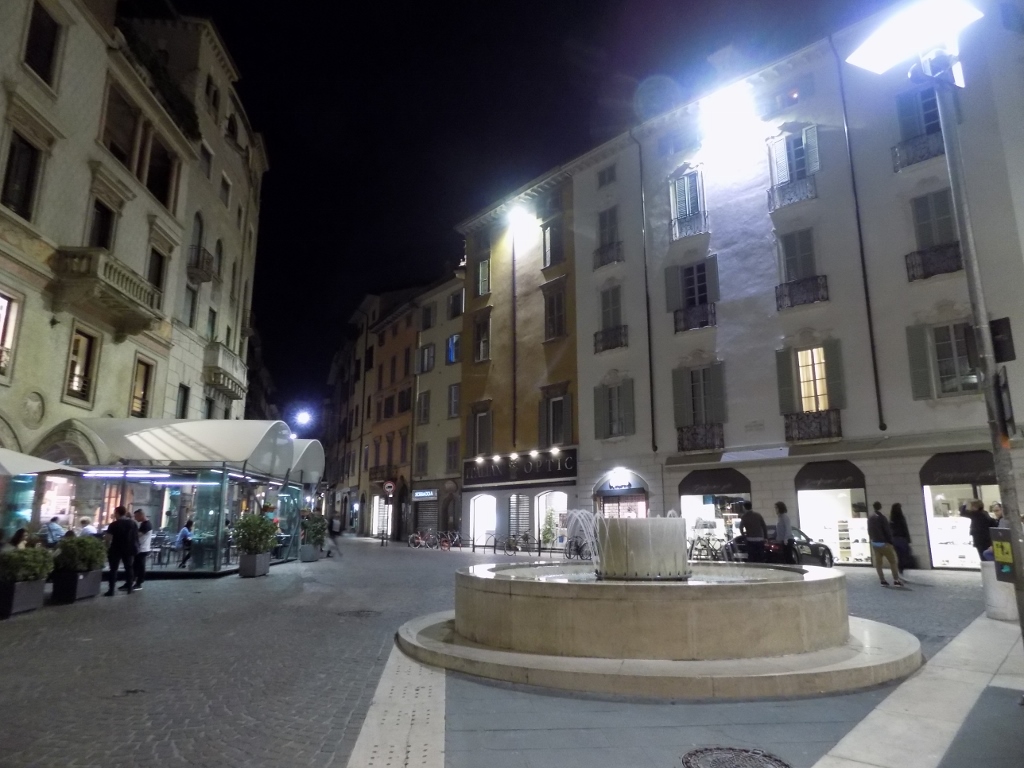 The small square in which I had a flat in Bergamo
The small square in which I had a flat in Bergamo
So, how do you know that you are “at home” in some foreign place and that the locals consider you to be “one of the crowd”? Here is how… When the waiter tells you while passing by: “Signora, una bionda media?,” meaning “Half a litre of the light one, madam?” Of course, he was referring to beer. No, this evening I decided to try some Bergamo version of the Aperol Spritz cocktail, just as a departure token. Still, the waiter kept treating me as a regular customer. Namely, the first two evenings he would immediately ask me to pay for the drink he had just brought. This time, when I wanted to pay at once, he said I should not bother and can do it later. It felt nice to have an impression of being “local” in Bergamo!
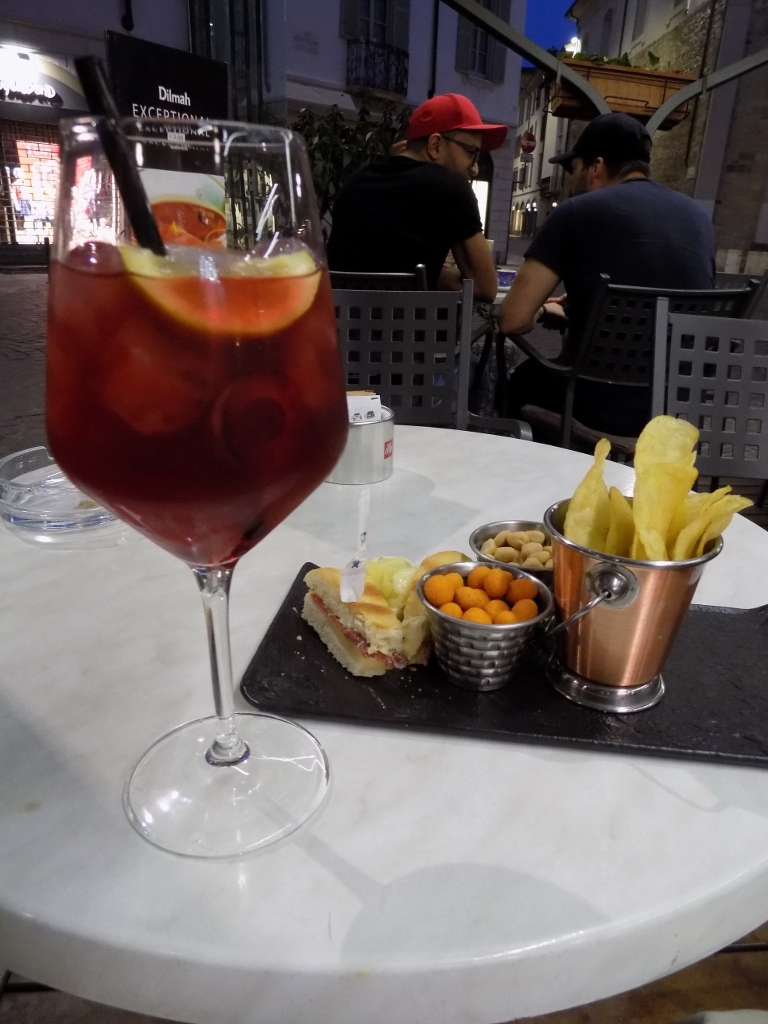 The cocktail for the last evening in Bergamo
The cocktail for the last evening in Bergamo